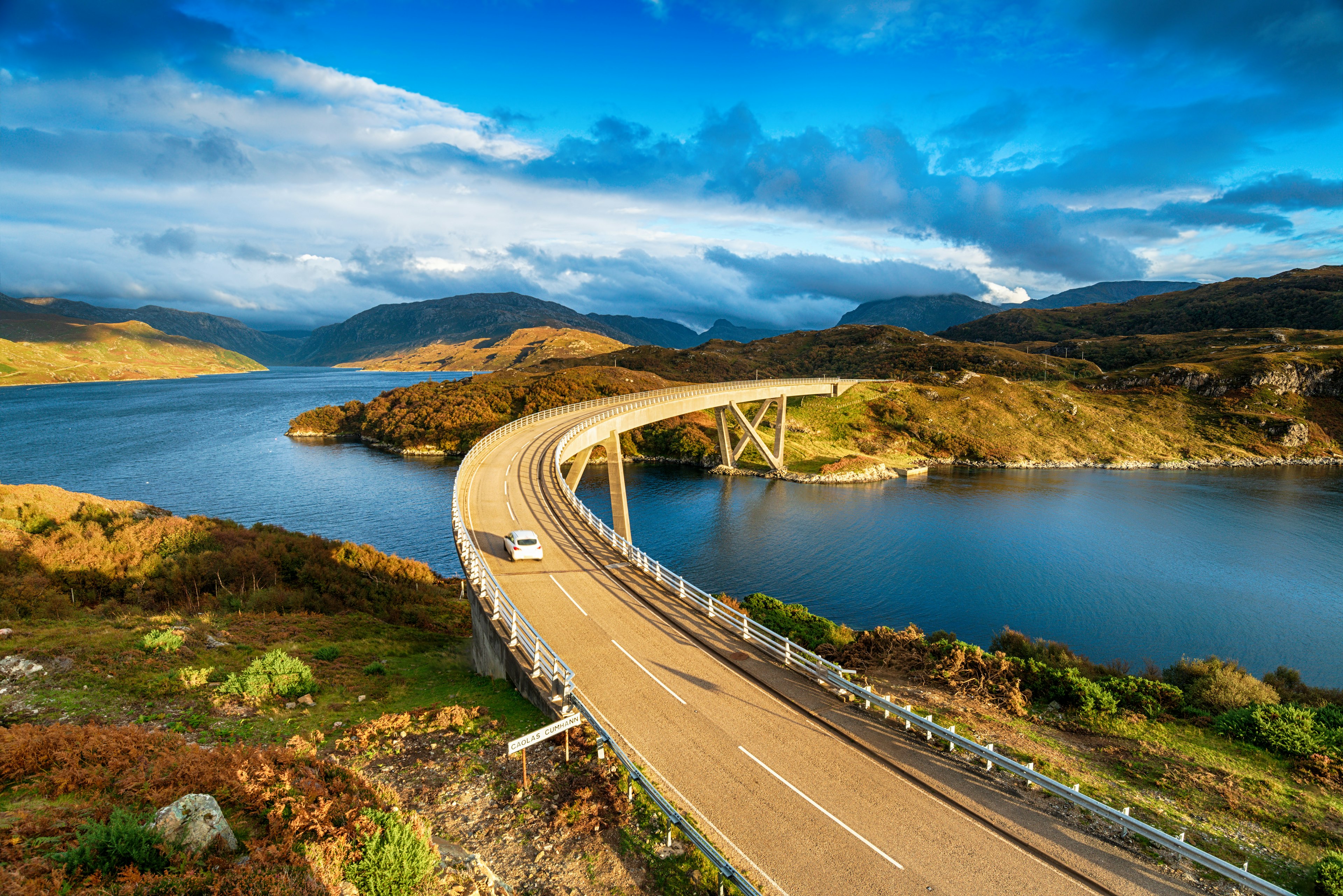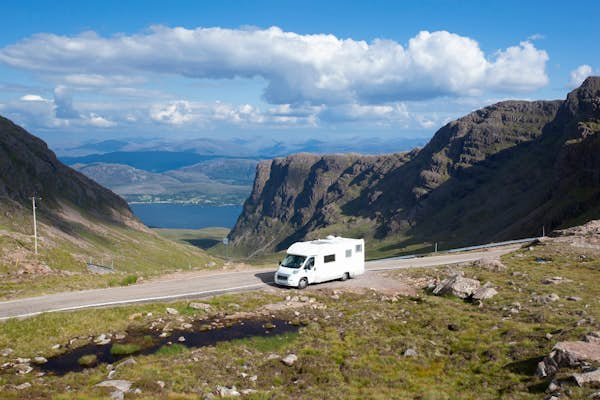Scotland’s culture-packed cities tempt visitors with their streets full of history and atmosphere, but it’s the nation’s wild and beautiful countryside that truly captures the heart of everyone who spends time here.
Classic Scottish landscapes of lochs, glens and mountains begin right on the limits of Edinburgh, Glasgow and other major cities, meaning you can switch from the speed of city life to a romantic road trip in no time at all.
Scottish roads are generally well-maintained, and driving is a great way to get off the beaten track and escape the crowds that flock to the most famous sights. En route, you can stop off in charming country pubs, drop into ruined castles and ancient kirks (churches), wander on windswept beaches and find solace in silent glens far from the maddening crowds.
These five road trip itineraries take in the epic grandeur of Skye, culture-packed Edinburgh and the whisky distilleries of Speyside, amongst other classic Scottish experiences. Along the way, you’ll pass rolling farmland, heather-burnished hillsides, ruined castles and eerie lochs, as the stories of Scotland unfold right in front of you.

1. An Isle of Skye driving loop
Best for making family memories
Fort William–Fort William; 310 miles; allow 4 days
So long as you’re not after guaranteed sunshine, Skye has it all. This atmospheric island off the west coast is a riot of craggy peaks, towering sea stacks and waterlogged shorelines, famed for its Gaelic culture and vibrant food scene. This round-trip route from Fort William allows you to take the bridge to the island in one direction (passing the grand Eilean Donan Castle en route), and return to the mainland via the ferry to Mallaig.
Once you’re on the island, a classic counterclockwise loop starts with a visit to Skye’s largest town, Portree, with its pretty harbor, before roaming over the volcanic cliffs of the Trotternish Peninsula. Next, the Duirinish Peninsula offers wild hiking country and some excellent restaurants, while the jagged ridges of the Cuillin Hills are a destination in themselves for hikers and photographers.
In between, there are castles, almost Caribbean-looking beaches and some of Britain’s best wild swimming spots, plus side trips by ferry to the surrounding Small Isles, which offer great bird-watching, particularly in spring and autumn.

2. North Coast 500
Best for a once-in-a-lifetime adventure
Inverness Castle–Inverness Castle; 516 miles; allow 7 days
Scotland’s wild northern coastline is the star of the country’s most famous driving route. The North Coast 500 begins and ends in Inverness, the likable capital of the Highlands, making a giant loop around the north end of Scotland along the deeply indented coast.
If you follow the route counterclockwise (saving the best scenery till last), you’ll head past the moors and sandy beaches of the east coast before hitting John O’Groats and nearby Dunnet Head – mainland Britain’s northernmost point. The north coast has a windswept beauty that gets increasingly rugged as you continue west past bogs, cliffs and crofting villages. The views as you head down the loch-strewn west coast are perhaps Britain’s finest, with sweeping vistas of mountains and islands.
Taking the route at a more leisurely pace will give you the chance to seek out fine local foodstuffs such as venison, smoked fish and craft beer, while activities such as sea kayaking on the west coast or scrambling up the lonely peaks of Assynt are a great way to throw yourself into Northern Scotland’s epic landscapes.
Planning tip: When planning a road trip in Scotland, be aware that many places to stay on popular routes, such as the North Coast 500, will only accept bookings for two or more nights in the summer peak season. Book accommodations well ahead of time.

3. North East 250
Best for whisky distillery touring
Spittal of Glenshee–Spittal of Glenshee; 257 miles; allow 4 days
Northeast Scotland is famous for its whisky distilleries, Braemar (the home of the Highland Games) and Balmoral Castle (the Scottish home of the British Royal Family) – so yes, it’s as Scottish as it gets. The North East 250, a route inspired by the success of the North Coast 500, takes in these big-ticket attractions, but also shines a light on an often-overlooked region of photogenic glens, farmland and wave-lashed shorelines.
The village of Spittal of Glenshee (a popular winter skiing base) is a good starting point and is easily accessible from Edinburgh and Dundee. Taking the route clockwise, you’ll head through the Cairngorms National Park, the biggest national park in Britain, which includes some of the UK’s highest peaks and offers phenomenal hiking opportunities.
The North East 250 then cuts through Speyside before hitting the Moray Firth coastline and the oil-rich city of Aberdeen. It’s a route lined with castles, beaches, small villages and historic estates; stop along the way to sample local delicacies such as Cullen skink (a thick, warming fish soup) and sweet, peaty whiskies.
Local tip: Do your research when choosing which whisky distilleries to tour – if you try to hit them all, you’ll be here for months. Balvenie in Dufftown is a good choice; its small-group tours visit one of Scotland’s last remaining malting floors.

4. Borders Historic Route
Best for a short route through moorlands
Carlisle–Edinburgh; 97 miles; allow one day
There may be more famous road trips than this easy itinerary that follows the A7 north from the English border past Hawick and Galashiels to Edinburgh, but this route is packed with delights to engage both body and spirit. This rolling landscape of villages and farmlands was once a battlefield for cross-border raids, and it finishes at Edinburgh’s hulking castle.
The area’s industrial history is showcased by educational centers celebrating tweed, tartan and glasswork, as well as an interesting mining museum. The landscape provides opportunities for varied activities – anglers can cast flies in the hope of snagging salmon along the Tweed’s wooded banks, while mountain bikers can hit the trails at Glentress and Innerleithen.
Ruined abbeys and author Walter Scott’s fabulous country house, Abbotsford, are more cerebral highlights, although the undulating moorlands of the Scottish Borders are arguably the star of the show.

5. Clyde Sea Lochs and the Argyll Coast
Best for mountains and lochs
Glasgow–Fort William; 240 miles; allow 3 days
Visitors to Scotland are often surprised by how close the country’s most populous city is to the rugged terrain of the Highlands. Glasgow’s high culture and lively pubs are worth an overnight on any trip to the region, but don’t stay up too late – you’ll want to be clear of the suburbs by mid-morning to see the hills turn to mountains and lochs eat into an increasingly rugged coastline.
This route winds north and west, taking in the popular walking country of Loch Lomond and the Trossachs. En route, you can enjoy majestic views, excellent seafood, ancient standing stones, historic towns, kayaking on the lochs and whale-watching offshore.
But the biggest hitters come at the end: Glencoe has aching natural beauty and a tragic backstory of Highland betrayal, while Fort William is the striking point for ascents of 4413ft up Ben Nevis, Britain’s tallest peak – a challenging climb of seven to eight hours from the visitors center.

Tips for driving in Scotland
Note that while some of the road trips follow major “M” or “A” roads, others rely on smaller roads for long stretches. These are often tight and hedge-lined, with few places to overtake, and they can be blocked by snow in winter (read our tips for getting around in Scotland).
The police in Scotland take speeding and drunk driving seriously, so stay below the limits. Petrol stations can be widely spaced in the Highlands and on the islands – fill up whenever you get the chance.
Be ready to take your time, pausing for a day or two to explore the local area at each overnight stop. Our route durations assume you’ll be taking diversions to see more of the region and making regular stopovers, so the distances provided are not direct between the start and end points.
This article was first published Jun 9, 2021 and updated Oct 16, 2024.

